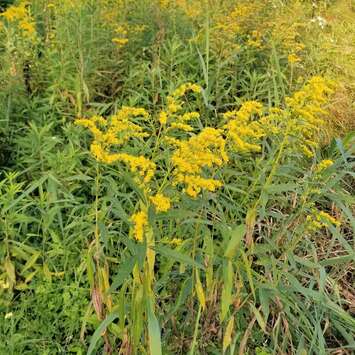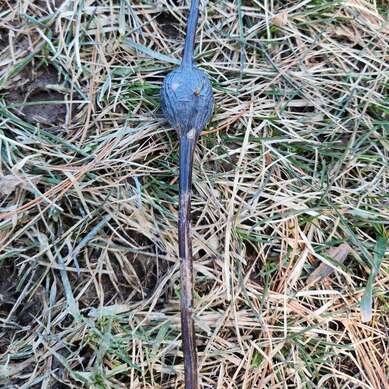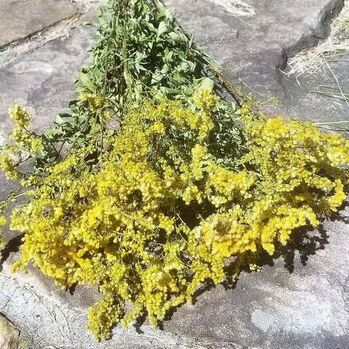GoldenrodGoldenrod belongs to the genus Solidago, but some goldenrods have recently been classified into the Oligoneuron or Euthamia genus as well due to new relationships discovered via DNA sequencing. Goldenrods consist of over 100 flowering plants in the Asteraceae family, many of which are native to the United States. The various species can be difficult to distinguish as many look similar to each other, most have yellow flowers. I have at least two species on my property, I believe they are Canada Goldenrod (S. canadensis), which is very common, but several other common species look very similar. I also have Old Field Goldenrod (S. nemoralis), which is one of the shortest varieties and therefore easier to identify. Goldenrod and AllergiesMany people blame the goldenrods for their allergies in late summer/early fall. However, the pollen of goldenrod does not become airborne because it is too large to float through the air. It is also sticky, so it clings to insect pollinators. Instead, it is ragweed that causes most fall allergies because its pollen is airborne and it flowers at the same time as goldenrod, but its flowers are much less showy than goldenrod, and so it is much less noticeable. Goldenrods are very important for many insects, including pollinators, and are a great addition to any native garden. They tend to flower later in the season from late summer to early fall, so they are a great food for the bees just before winter when many other plants have finished flowering. Goldenrods also tend to like dry soils, although several grow well in wet environments, and most are very low maintenance. Goldenrod GallsGoldenrod galls are ball-shaped swellings found on goldenrod stems, including Canada Goldenrod (S. canadensis), Late Goldenrod (S. altissima), and Giant/Late Goldenrod (S. gigantea). These galls are caused by the goldenrod gall fly (Eurosta solidagnis). This fly completes its lifecycle only on goldenrods. A fly lays its eggs in the goldenrod stem in the spring. Once the eggs hatch, the larvae burrow inside and feed on the stem. The larvae’s saliva contains a chemical that mimics a natural plant hormone. This chemical hormone mimic makes the stem grow excessively around the larvae forming the gall. The galls do not harm the goldenrod and you generally see the flowers blooming around the gall. Once the plant dies back in the fall the gall turns hard and brown and the larva chews a hole to the surface of the gall, leaving a thin layer covering the entrance. The larva survives through winter, pupates in early spring inside the gall turning into an adult fly. The fly then emerges in mid-spring, pushing through the membrane left behind to cover the entrance. The goldenrod gall larvae are not necessarily safe inside the gall. There are two different species of wasps (Eurytoma obtusiventris and Eurytoma gigantea) that eat the larvae inside the gall as well as a species of beetle (Mordellistena unicolor) that eats the tissue inside the gall and occasionally eats the goldenrod gall larvae as well. The larvae in the galls also serve as a food source for birds including the downy woodpeckers and black-capped chickadees. Other goldenrods can also form galls caused by different insects including the goldenrod bunch gall midge (Rhopalomyia solidaginis) and the goldenrod gall moth (Gnorimoschema gallesolidaginis). Goldenrods of the MidwestAccording to BONAP the following goldenrod species are native to Wisconsin, and for many of them much of the Midwest and beyond as well. Euthamia GenusEuthamia graminfolia – Grass-Leaved Goldenrod – This goldenrod is not considered a true goldenrod which is why it has been moved to the Euthamia genus. This goldenrod has narrow leaves, giving it its name. It prefers sunny locations with moist soil but can be aggressive in these locations as it spreads via rhizomes. Many insects are attracted to this plant including the Goldenrod Soldier Beetle (Chauliognathus pennsylvanicus) and the Black Blister Beetle (Epicauta pensylvanica). Birds such as Eastern Goldfinches and Swamp Sparrows also eat the seeds. Generally 2-4 feet in height and can be confused with Great Plains Goldenrod. Euthamia gymnospermoides – Great Plains Goldenrod – This goldenrod prefers full sun but can adapt to moist or dry soils. It grows up to 3 feet tall and can be aggressive as it has both fibrous roots and rhizomes. This goldenrod looks similar to Grass-Leaved Goldenrod. Oligoneuron GenusOligoneuron album – Upland White Goldenrod or Prairie Goldenrod– This goldenrod is unusual for its white flowers and short height (12-24 inches tall). It prefers full sun with drier soil, even sandy, rocky soil. This goldenrod has been renamed multiple times due to genetic sequencing and is currently placed in the Oligoneuron genus but was formerly called Solidago ptarmicoides. Oligoneuron ohioense – Ohio Goldenrod – This goldenrod likes full sun but with wet soil, it even does well in clay soils that are not particularly well-drained. This goldenrod is threatened in some areas due to its requirement for wet, marshy soils. So this is a great one to plant if you have the right growing conditions and you are helping sustain its population. Oligoneuron riddellii – Riddell’s Goldenrod – This goldenrod used to be in the Solidago genus but was recharacterized as Oligoneuron. It needs full sun but preferably wet soil. Many insects enjoy this plant which also brings in insectivorous birds looking for food. Birds, such as sparrows and goldfinches, also feed on the seeds. Many bees are attracted to the flowers including bumble bees, carpenter bees, Andrenid bees, yellow-faced bees, and digger bees. It grows up to 40 inches tall. Oligoneuron rigidum (formerly S. rigida) – Stiff Goldenrod – Several Solidago species, including Stiff Goldenrod, have recently been moved to the Oligoneuron genus. This goldenrod has larger flowers than most other goldenrods. It can self-seed so if it is planted in an area where you do not want seedlings popping up everywhere then the seed heads should be clipped off. This flower likes sunny conditions but can tolerate dry to moist soil and can grow up to 4-5 feet tall. This goldenrod attracts many insects including butterflies and bees as well as birds. Solidago SpeciesSolidago altissima – Tall Goldenrod – This goldenrod prefers full sun and dry to moist soils. Very similar to Canada Goldenrod and Late Goldenrod and all three can be difficult to distinguish. This goldenrod also hosts many different gall-forming insects. Solidago caesia – Blue-Stemmed Goldenrod – This golden rod is not aggressive but prefers shade and moist soil. It is named for its blue or purple stem. Solidago canadensis – Canada Goldenrod – Similar to Tall Goldenrod and Late Goldenrod. This plant can get up to 5 feet tall and prefers full sun and dry to moist soil. This can be an aggressive spreader and is considered invasive in many European countries where it was introduced from North America. This is not a good choice for small flowerbeds or areas where you want to keep goldenrod from spreading but I love it on our property where we have large fields of it (unfortunately mixed in with several invasive species such as tansy) and no need to keep it contained. This species also hosts many gall-forming insects and we have found many galls on the goldenrod on our property. Solidago flexicaulis – Zigzag Goldenrod – This goldenrod looks different, particularly the leaves which are larger than many other goldenrods and the stem changes direction at every leaf node creating a zigzag effect. It can be aggressive so it should not be planted in areas where you want to contain the growth of your plants. This goldenrod also prefers more shady conditions with more moist soil than many other goldenrods. It can grow up to 3 feet tall. This goldenrod can also play host to insects that induce galls in the plant. Solidago gigantea – Late Goldenrod or Giant Goldenrod – This goldenrod prefers moist soil, can thrive in full sun to partial shade, and can reach heights of six feet. This goldenrod can easily be confused with Tall Goldenrod and Canada Goldenrod. Solidago hispida – Hairy Goldenrod – This goldenrod likes partial shade to full sun. It does well in dry sandy or gravely soil where it grows up to 3 feet tall. The leaves have tiny hairs on them giving this goldenrod its name. Solidago juncea – Early Goldenrod – This goldenrod is one of the earliest to bloom, as early as July in some places, hence the name, Early Goldenrod. It is medium sized from 2-4 feet tall and grows in moist to dry soils and likes sunny to partially sunny conditions. This goldenrod does spread by rhizomes so it may need to be thinned out occasionally and requires some effort if you wish to keep it contained. Solidago lepida – Western Canada Goldenrod – This goldenrod is common across Canada and the western United States. Wisconsin is the most eastern occurring location in the United states but it is not found to the south, except further west. This goldenrod can reach up to 5 feet. Solidago missouriensis – Missouri Goldenrod – Very similar to Early Goldenrod but does not spread by rhizomes so less aggressive. Does like full sun and more dry soils. Can grow up to 3 feet. One of the earlier blooming goldenrods, can be as early as mid-July. Solidago mollis – Velvety Goldenrod – This goldenrod prefers full sun with dry to moist soils. It is rare in Minnesota and Wisconsin and was listed as a Special Concern species in 1984 by Minnesota. Solidago nemoralis – Old Field Goldenrod or Gray Goldenrod – This is one of the shorter goldenrods, no more than 2 feet high. It will grow in poor, dry soils where other plants have difficulty getting established. Like most Goldenrods, S. nemoralis will attract butterflies and various pollinators. Solidago patula – Round-Leaved Goldenrod – This Goldenrod prefers shade and moist soils and can reach 3 feet in height. Solidago rugosa – Wrinkleleaf Goldenrod – This goldenrod is found through much of the eastern United States and Canada, as far west as Wisconsin in the North and Texas in the South. This goldenrod looks similar to Bog Goldenrod. Soldidago sciaphila – Cliff Goldenrod – A rare goldenrod listed as a Special Concern species by Minnesota in 1984. It is shorter in size than most others, no more than 30 inches high. This goldenrod likes dry soil with mostly sunny conditions. Grows well on rocky outcroppings, giving it its name. Solidago speciosa – Showy Goldenrod – This goldenrod is not an aggressive grower like others in the Solidago genus because it does not spread via rhizomes, so it is a good choice if you have a smaller flower bed that you do not want to be overrun with a single species. This flower does well in sunny conditions with more dry soil and can grow up to 4-5 feet high. This goldenrod attracts many insects including many types of bees such as sweat bees, bumble bees, carpenter bees, Andrenid bees, and more. Solidago uliginosa – Bog Goldenrod – This goldenrod forms tall, up to 4-5 foot spikes, which look very different from the flowers of most other goldenrods. This goldenrod prefers shade with moist soils hence the common name of Bog Goldenrod. Solidago ulmifolia – Elm-Leaved Goldenrod – This goldenrod is native to much of the eastern United States to the Midwest. They prefer moist soils in shade or partial shade and do self-seed prolifically. They also have rhizomes so spreading by both seed and root is likely. The leaves are similar to elm trees giving this goldenrod its name. This goldenrod grows to 2-4 feet tall. References
0 Comments
|
Details
AuthorIn 2016, my family and I moved from the New York City area to small town Wisconsin. Our move, this website and blog (and our previous Etsy store) is the result of our desire over the past several years to simplify our lives, increase our quality of life, reconnect with nature, and enjoy a more self-sufficient life. I grew up as a country kid in central Pennsylvania working on my grandfather's fruit farm and as a corn "de-tassler" at a local seed farm. My background is in biology where my love of nature originated. I am a former research scientist and professor and have now transitioned to a part-time stay-at-home mom, self-employed tutor, and small business owner. Thank you for taking the time to check out my site. Archives
April 2024
Categories
All
|



 RSS Feed
RSS Feed